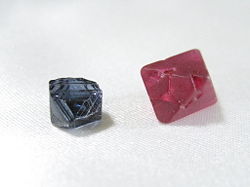Spinel
| Spinel | |
|---|---|
 |
|
| General | |
| Category | Mineral |
| Chemical formula | MgAl2O4 |
| Identification | |
| {{{molweight}}} | |
| Color | Various, red to blue to mauve. Dark green, brown. Black |
| Crystal habit | Cubic, octahedral |
| Crystal system | Isometric |
| Cleavage | Indistinct |
| Fracture | Conchoidal, uneven |
| Mohs Scale hardness | 8.0 |
| Luster | Vitreous |
| Refractive index | 1.712-1.762 |
| Pleochroism | Absent |
| Streak | White |
| Specific gravity | 3.54-3.63 |
| {{{density}}} | |
The spinels are any of a class of minerals which crystallize in the isometric system with an octahedral habit. The general formula is as (X)(Y)2O4, with X representing cations occupying tetrahedral sites and Y cations occupying octahedral sites. Divalent, trivalent, and quadrivalent cations can occupy the X and Y sites, and they include magnesium, zinc, iron, manganese, aluminium, chromium, titanium, and silicon.
The oxygen anions are arranged in a cubic close-packed structure. In the normal spinel structure, X cations occupy the tetrahedral sites, and Y the octahedral sites. For inverse spinels, half the Y cations occupy the tetrahedral sites, and both X and Y cations occupy the octahedral sites.
Important members of the spinel group include:
- Spinel – MgAl2O4, after which this class of minerals is named
- Gahnite - ZnAl2O4
- Franklinite - (Fe,Mn,Zn)(Fe,Mn)2O4
- Chromite - (Fe·Mg)Cr2O4
- Magnetite - Fe3O4
- Hercynite - FeAl2O4
- Ulvöspinel - TiFe2O4
- Jacobsite - MnFe2O4
- Trevorite - NiFe2O4
- Ringwoodite - SiMg2O4, an abundant olivine polymorph within the Earth's mantle from about 520 to 660 km depth, and a rare mineral in meteorites
True spinel has long been found in the gemstone-bearing gravel of Sri Lanka and in limestones of Myanmar and Thailand.
Spinel usually occurs in isometric crystals, octahedrons, usually twinned. It has an imperfect octahedral cleavage and a conchoidal fracture. Its hardness is 8, its specific gravity is 3.5-4.1 and it is transparent to opaque with a vitreous to dull lustre. It may be colorless, but is usually various shades of red, blue, green, yellow, brown or black. There is a unique natural white spinel, now lost, that surfaced briefly in what is now Sri Lanka. Another famous spinel is the Black Prince's Ruby in the British Crown Jewels.
The transparent red spinels are called spinel-rubies or balas-rubies and were often confused with actual rubies in ancient times. "Balas" is derived from Balascia, the ancient name for Badakhshan, a region in central Asia situated in the upper valley of the Kokcha river, one of the principal tributaries of the Oxus river. Yellow spinel is called rubicelle and violet-colored manganese-bearing spinel is called almandine.
Spinel is found as a metamorphic mineral, and also as a primary mineral in basic rocks, because in such magmas the absence of alkalis prevents the formation of feldspars and any aluminium oxide present will form corundum or combine with magnesia to form spinel. This is why spinel and ruby are often found together.
Spinel, (Mg,Fe)(Al,Cr)2O4, is common in peridotite in the uppermost Earth's mantle, between the Mohorovicic discontinuity (the Moho) and a depth of 70 kilometers or so; below that depth, the spinel (if present) becomes increasingly rich in chromium, as with increasing depth, pyrope-rich garnet becomes the more stable aluminous mineral in peridotite. At depths significantly shallower than the Moho, calcic plagioclase is the more stable aluminous mineral in peridotite.
ReferencesISBN links support NWE through referral fees
- Deer, Howie and Zussman (1966) An Introduction to the Rock Forming Minerals, Longman, pp.424-433, ISBN 0-582-44210-9
- Shumann, Walter (2006) Gemstones of the World 3rd edition, Sterling, pp.116-117.
- Spinel structure by Steven Dutch
- Spinel structure
Weblinks
cs:Spinel de:Spinell fr:Spinelle it:Spinello he:ספינל nl:Spinel ja:スピネル pl:Spinel pt:Espinela sr:Магнезијум алуминат fi:Spinelli sv:Spinell